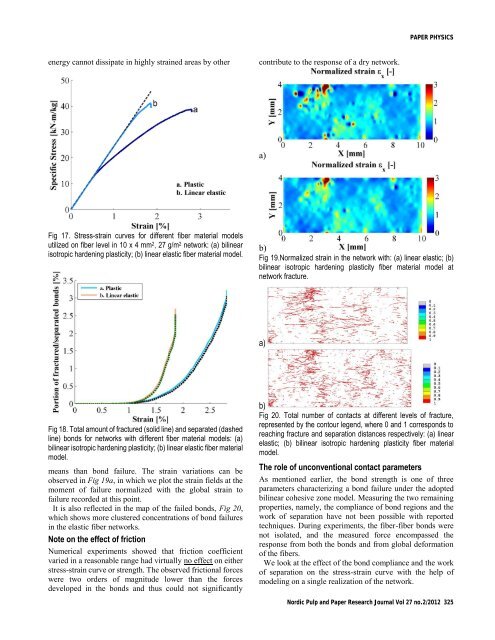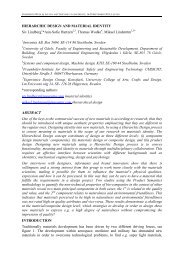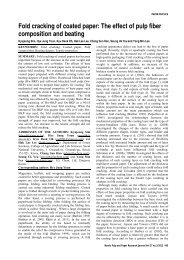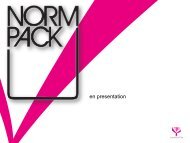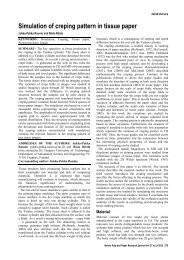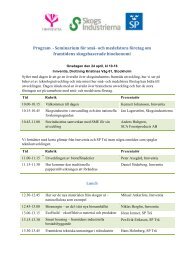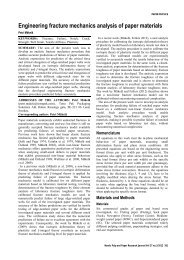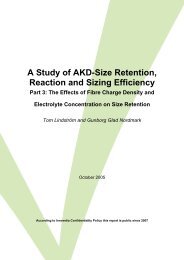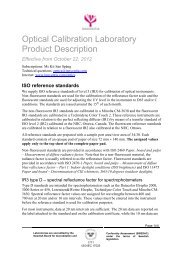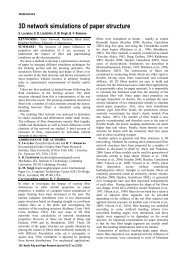Stress-strain curve of paper revisited - Innventia.com
Stress-strain curve of paper revisited - Innventia.com
Stress-strain curve of paper revisited - Innventia.com
Create successful ePaper yourself
Turn your PDF publications into a flip-book with our unique Google optimized e-Paper software.
PAPER PHYSICS<br />
energy cannot dissipate in highly <strong>strain</strong>ed areas by other<br />
contribute to the response <strong>of</strong> a dry network.<br />
a)<br />
Fig 17. <strong>Stress</strong>-<strong>strain</strong> <strong>curve</strong>s for different fiber material models<br />
utilized on fiber level in 10 x 4 mm 2 , 27 g/m 2 network: (a) bilinear<br />
isotropic hardening plasticity; (b) linear elastic fiber material model.<br />
b)<br />
Fig 19.Normalized <strong>strain</strong> in the network with: (a) linear elastic; (b)<br />
bilinear isotropic hardening plasticity fiber material model at<br />
network fracture.<br />
a)<br />
Fig 18. Total amount <strong>of</strong> fractured (solid line) and separated (dashed<br />
line) bonds for networks with different fiber material models: (a)<br />
bilinear isotropic hardening plasticity; (b) linear elastic fiber material<br />
model.<br />
means than bond failure. The <strong>strain</strong> variations can be<br />
observed in Fig 19a, in which we plot the <strong>strain</strong> fields at the<br />
moment <strong>of</strong> failure normalized with the global <strong>strain</strong> to<br />
failure recorded at this point.<br />
It is also reflected in the map <strong>of</strong> the failed bonds, Fig 20,<br />
which shows more clustered concentrations <strong>of</strong> bond failures<br />
in the elastic fiber networks.<br />
Note on the effect <strong>of</strong> friction<br />
Numerical experiments showed that friction coefficient<br />
varied in a reasonable range had virtually no effect on either<br />
stress-<strong>strain</strong> <strong>curve</strong> or strength. The observed frictional forces<br />
were two orders <strong>of</strong> magnitude lower than the forces<br />
developed in the bonds and thus could not significantly<br />
b)<br />
Fig 20. Total number <strong>of</strong> contacts at different levels <strong>of</strong> fracture,<br />
represented by the contour legend, where 0 and 1 corresponds to<br />
reaching fracture and separation distances respectively: (a) linear<br />
elastic; (b) bilinear isotropic hardening plasticity fiber material<br />
model.<br />
The role <strong>of</strong> unconventional contact parameters<br />
As mentioned earlier, the bond strength is one <strong>of</strong> three<br />
parameters characterizing a bond failure under the adopted<br />
bilinear cohesive zone model. Measuring the two remaining<br />
properties, namely, the <strong>com</strong>pliance <strong>of</strong> bond regions and the<br />
work <strong>of</strong> separation have not been possible with reported<br />
techniques. During experiments, the fiber-fiber bonds were<br />
not isolated, and the measured force en<strong>com</strong>passed the<br />
response from both the bonds and from global deformation<br />
<strong>of</strong> the fibers.<br />
We look at the effect <strong>of</strong> the bond <strong>com</strong>pliance and the work<br />
<strong>of</strong> separation on the stress-<strong>strain</strong> <strong>curve</strong> with the help <strong>of</strong><br />
modeling on a single realization <strong>of</strong> the network.<br />
Nordic Pulp and Paper Research Journal Vol 27 no.2/2012 325


